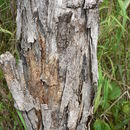Biology
provided by Arkive
African blackwood is a deciduous tree, loosing its foliage in the dry season; flowers appear in the second half of the dry season (5). This tree is long-lived and extremely slow-growing (6). African blackwood is a vital component of the African savanna ecosystem; the nodules on the roots fix nitrogen producing a more fertile soil, the leaves provide vital browse for herbivores, and the extensive root system stabilizes the soil (6). Mature African blackwood trees are resistant to fire (6).
Different parts of the tree have been used as herbal remedies over the years; the bark may be used to treat diarrhoea, the root is burnt for a smoke-inhalation cure of headaches and colds, and there are many other traditional uses of this important tree in different areas within its range (3).
Conservation
provided by Arkive
The African blackwood is the National Tree of Tanzania; it is an immensely important tree, both culturally and economically, and the sustainable management of this tree is vital if trade in its heartwood is to continue (4). The African Blackwood Conservation Project (ABCP) was founded in 1996, it is working to cultivate young trees with the view to replanting them in areas where it has disappeared (5). Education is also a large part of their work, and the ABCP has set up school programmes in Tanzania to increase the awareness of local people for the conservation issues involved (5). Fauna & Flora International (FFI) have also been heavily involved with the conservation of the African blackwood tree, particularly through their Global Trees Campaign (4). It is hoped that adopting sustainable measures now will allow this ancient, musical tree to survive.
Description
provided by Arkive
This small, unassuming tree conceals one of the most sought-after and valuable heartwoods in the world. Stripping away the yellowish grey sapwood reveals the deep purple to brownish black core, this wood is extremely resistant and durable and is known variously as African blackwood, African ebony, 'poyi' and (in Swahili) as 'mpingo' (2). These trees are small and heavily branched, the trunks are seldom straight and many stems may be present; the rough bark is grey with many fissures, and the branches have small spines (2). Leaves are up to 22 centimetres long and carry small, oval-shaped leaflets (2). In season, the branches of the African blackwood tree are adorned with tiny, white, sweetly-smelling flowers born as clusters on inflorescences, which may reach 12 centimetres in length (2). The seedpods of this tree are flattened oblong cases that are roughly pointed, and contain one or two seeds (2).
Habitat
provided by Arkive
Found in deciduous woodland and savanna, often associated with dry, rocky areas and poor soils (2).
Range
provided by Arkive
The African blackwood is native to 26 African countries (4); it is found from Mozambique north to Ethiopia and west from the east African coast to Senegal (3). The main strongholds of the tree however, are southern Tanzania and northern Mozambique (5)
Status
provided by Arkive
Classified as Lower Risk/ near threatened (LR/nt) on the IUCN Red List 2002 (1).
Threats
provided by Arkive
The African blackwood has been highly prized for many centuries for the properties of its heartwood; the oily, fine wood was used by the Egyptians for tomb artefacts (5). The dark, resistant wood has been used to make utensils, and the Makonde tribe of East Africa make intricate carvings, which are now an important source of tourist revenue (5). African blackwood is possibly most famous however, for the manufacture of woodwind instruments. The unique properties of this heartwood are seen as vital for the production of top quality clarinets; it is dense, resistant, and produces a beautiful tone (4). The export of timber for the manufacture of musical instruments is an important source of income in countries such as Tanzania, where processed timber fetches up to US$13,000 per m³ (5). It is however, a highly inefficient process and up to 90% of a tree will be discarded as unsuitable (4). Whilst the mature trees are being harvested for this trade, younger specimens are under increasing pressure from man-made bushfires, which have increased in frequency as the land is cleared for agriculture (6). It is feared that the continued uncontrolled exploitation of the African blackwood tree will cause it to become commercially extinct within a few decades (5); it is already threatened in Kenya and noticeably scarcer within Tanzania (6).

